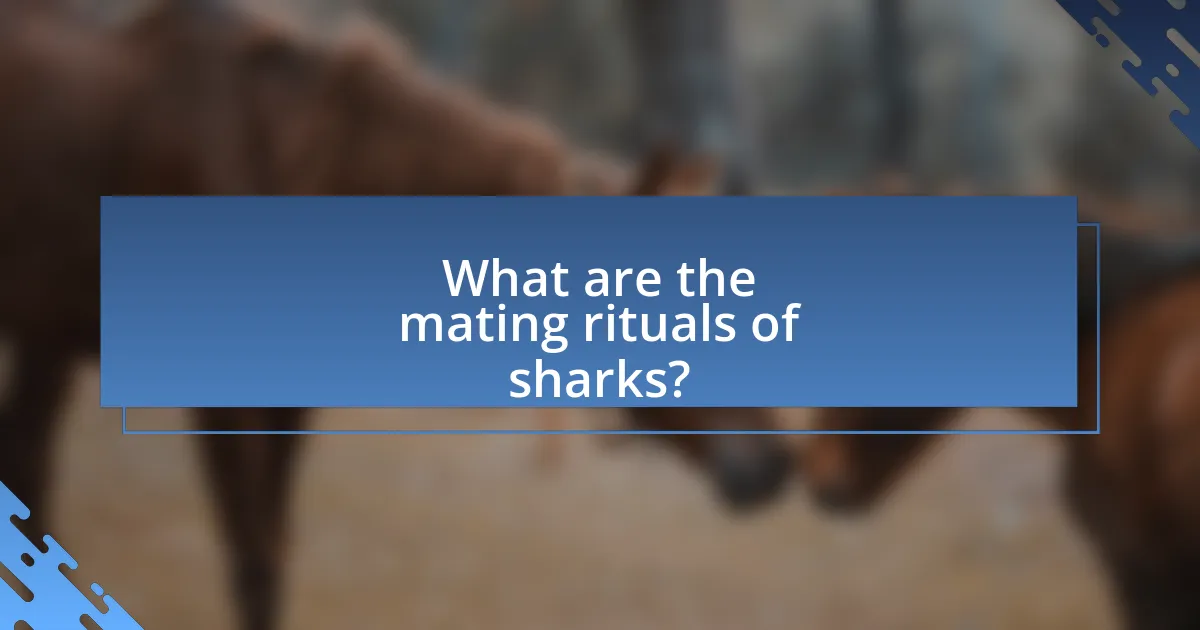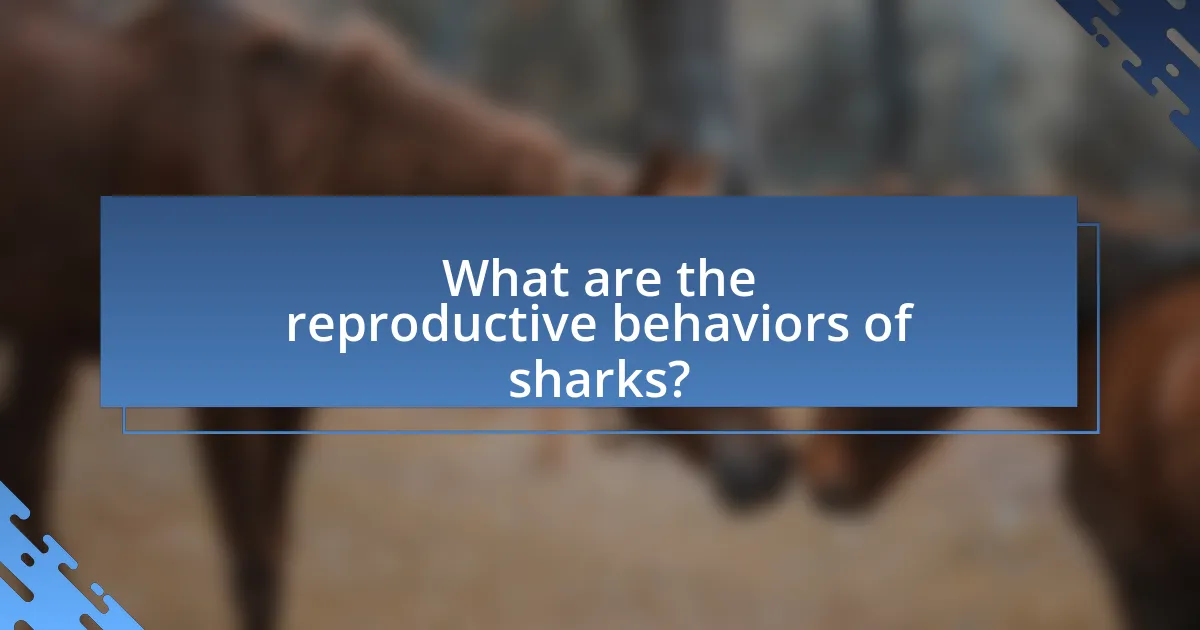The article focuses on the mating rituals and reproductive behaviors of sharks, detailing the complex courtship practices that vary among species. It explores how male sharks attract females through physical displays and chemical signals, as well as the responses of females to these courtship behaviors. The article also examines the influence of environmental factors on mating, the different reproductive methods employed by sharks, and the challenges they face due to human activities such as overfishing and habitat destruction. Additionally, it highlights the importance of conservation efforts in protecting shark populations and ensuring their reproductive success.

What are the mating rituals of sharks?
Sharks engage in complex mating rituals that often involve courtship behaviors, such as biting and swimming in tandem. During the mating process, male sharks typically grasp the female with their teeth to hold her in place, which can result in visible bite marks on the female’s body. This behavior is part of a broader courtship display that may include swimming close together and performing acrobatic movements. Research indicates that these rituals can vary significantly among different shark species, with some exhibiting more elaborate behaviors than others. For instance, the hammerhead shark is known for its unique mating dances, which involve synchronized swimming patterns.
How do sharks attract mates during the mating season?
Sharks attract mates during the mating season primarily through chemical signals known as pheromones. These pheromones are released into the water and can be detected by other sharks, signaling reproductive readiness. Additionally, male sharks may engage in physical displays, such as circling and nudging, to demonstrate their interest and establish dominance. Research indicates that these behaviors are crucial for successful mating, as they help ensure that both parties are receptive and compatible.
What behaviors do male sharks exhibit to court females?
Male sharks exhibit several distinct behaviors to court females, including biting, nudging, and displaying specific swimming patterns. These actions are part of a complex courtship ritual aimed at attracting a mate. For instance, male sharks often bite the female’s fins or body to establish dominance and signal their interest, a behavior observed in species like the great white shark. Additionally, males may engage in elaborate swimming displays, such as circling or swimming alongside the female, to demonstrate their fitness and readiness to mate. These behaviors are crucial for successful mating, as they help males communicate their intentions and assess the receptiveness of females.
How do female sharks respond to male courtship behaviors?
Female sharks typically respond to male courtship behaviors by exhibiting a range of behaviors that indicate receptivity or rejection. When a male shark displays courtship behaviors, such as swimming closely, nudging, or biting, the female may respond positively by allowing the male to approach and engage in mating rituals. Research indicates that female sharks often display specific body postures or movements that signal their readiness to mate, such as elevating their bodies or swimming in a particular manner. Conversely, if a female is not receptive, she may exhibit aggressive behaviors, such as biting back or swimming away, to deter the male. This dynamic interaction is crucial for successful mating, as it helps ensure that only compatible partners engage in reproduction.
What role does the environment play in shark mating rituals?
The environment plays a crucial role in shark mating rituals by influencing the availability of suitable habitats and the timing of reproductive behaviors. Sharks often seek specific environmental conditions, such as warmer waters and areas with abundant prey, to facilitate mating. For instance, many shark species migrate to coastal nurseries or shallow waters during breeding seasons, where environmental factors like temperature and salinity are optimal for reproduction. Research indicates that these environmental cues can trigger hormonal changes in sharks, promoting mating behaviors.
How do water temperature and habitat influence mating behaviors?
Water temperature and habitat significantly influence the mating behaviors of sharks by affecting their reproductive cycles and courtship activities. Warmer water temperatures often trigger increased metabolic rates in sharks, leading to heightened activity levels and more frequent mating displays. For instance, species like the blacktip reef shark exhibit seasonal mating behaviors that align with warmer months, as observed in studies conducted in tropical regions. Additionally, specific habitats, such as shallow coastal areas, provide optimal conditions for mating due to increased visibility and accessibility for courtship rituals. Research indicates that sharks often aggregate in these environments during breeding seasons, enhancing their chances of successful reproduction.
What specific locations do sharks prefer for mating?
Sharks prefer specific locations for mating, primarily shallow coastal waters, estuaries, and areas near coral reefs. These environments provide safety from predators and abundant food sources, which are crucial during the mating process. For instance, species like the blacktip reef shark are known to gather in shallow lagoons for mating, while hammerhead sharks often mate in deeper waters near continental shelves. Research indicates that these locations facilitate successful mating by offering suitable conditions for both the male and female sharks to engage in courtship behaviors and ensure the survival of their offspring.
Why are mating rituals important for shark species survival?
Mating rituals are crucial for shark species survival as they facilitate successful reproduction and genetic diversity. These rituals, which often include elaborate courtship behaviors and displays, help ensure that mating pairs are compatible, thereby increasing the likelihood of producing viable offspring. For instance, species like the hammerhead shark engage in synchronized swimming and physical interactions that strengthen pair bonds and enhance reproductive success. Additionally, successful mating rituals contribute to the genetic diversity of shark populations, which is vital for adapting to environmental changes and resisting diseases. This genetic variability is essential for the long-term survival of shark species, as evidenced by studies showing that populations with higher genetic diversity are more resilient to threats such as climate change and overfishing.
How do these rituals affect genetic diversity in shark populations?
Mating rituals in sharks significantly influence genetic diversity within their populations by promoting selective mating and facilitating gene flow. These rituals, which often involve complex behaviors such as courtship displays and territoriality, help ensure that individuals with desirable traits reproduce, thereby enhancing the genetic quality of offspring. For instance, studies have shown that species like the blacktip reef shark exhibit specific mating behaviors that lead to increased genetic variation among their young, as these behaviors encourage mating with multiple partners rather than a single mate. This practice reduces inbreeding and allows for a broader genetic pool, which is crucial for the adaptability and resilience of shark populations in changing environments.
What threats do sharks face that impact their mating success?
Sharks face several threats that significantly impact their mating success, including overfishing, habitat loss, and climate change. Overfishing reduces shark populations, leading to decreased mating opportunities and genetic diversity. Habitat loss, particularly the destruction of breeding grounds due to coastal development and pollution, further limits their ability to find mates. Climate change affects ocean temperatures and currents, disrupting migration patterns and reproductive cycles. These factors collectively hinder the reproductive success of shark species, as evidenced by studies showing declining populations and altered breeding behaviors in various shark species.

What are the reproductive behaviors of sharks?
Sharks exhibit diverse reproductive behaviors, primarily categorized into three methods: oviparity, viviparity, and ovoviviparity. Oviparous sharks, such as the horn shark, lay eggs that develop outside the mother’s body, while viviparous species, like the great white shark, give birth to live young after a gestation period. Ovoviviparous sharks, such as the tiger shark, retain eggs inside their bodies until they hatch, resulting in live births. These reproductive strategies are adaptations to their environments, enhancing survival rates of offspring. For instance, the gestation period for some shark species can range from 10 months to over two years, demonstrating their unique reproductive adaptations.
How do sharks reproduce: oviparous, viviparous, or ovoviviparous?
Sharks reproduce through three main methods: oviparous, viviparous, and ovoviviparous. Oviparous sharks lay eggs that develop outside the mother’s body, such as the horn shark. Viviparous sharks give birth to live young that develop inside the mother, like the great white shark. Ovoviviparous sharks retain eggs inside their bodies until they hatch, resulting in live births, as seen in species like the tiger shark. These reproductive strategies reflect the diverse adaptations of sharks to their environments.
What are the differences between these reproductive methods?
Sharks exhibit three primary reproductive methods: oviparity, viviparity, and ovoviviparity. Oviparous sharks lay eggs that develop outside the mother’s body, such as the horn shark, which produces egg cases that adhere to substrates. Viviparous sharks, like the great white shark, give birth to live young after a gestation period, providing nutrients through a placenta-like structure. Ovoviviparous sharks, such as the tiger shark, retain eggs within their bodies until they hatch, allowing the young to be born live without direct nourishment from the mother. These methods reflect adaptations to environmental conditions and reproductive strategies, influencing survival rates and offspring development.
How does each method affect the survival of shark offspring?
Shark offspring survival is significantly influenced by the reproductive method employed by the species. Sharks utilize three primary reproductive strategies: oviparity, viviparity, and ovoviviparity. Oviparous sharks, such as the horn shark, lay eggs that develop outside the mother’s body, providing a safe environment but exposing the eggs to predation. In contrast, viviparous sharks, like the great white shark, give birth to live young, which enhances survival rates due to maternal nourishment during gestation. Ovoviviparous sharks, such as the tiger shark, retain eggs within their bodies until they hatch, combining benefits of both methods by protecting the developing young while still allowing for live birth. Each method’s impact on survival is evident; for instance, studies show that live-bearing species often have higher offspring survival rates due to reduced predation risks compared to egg-laying species.
What is the gestation period for different shark species?
The gestation period for different shark species varies significantly, ranging from about 5 months to over 3 years. For instance, the great white shark has a gestation period of approximately 11 months, while the hammerhead shark’s gestation can last around 9 to 12 months. In contrast, the spiny dogfish shark exhibits one of the longest gestation periods, lasting up to 24 months. These variations are influenced by factors such as species, environmental conditions, and reproductive strategies.
How does the gestation period vary among species?
The gestation period varies significantly among shark species, ranging from about 5 months to over 3 years. For instance, the spiny dogfish shark has a gestation period of approximately 2 years, while the bull shark typically has a gestation period of around 10 to 11 months. This variation is influenced by factors such as species, environmental conditions, and reproductive strategies. Research indicates that longer gestation periods may allow for the development of larger and more viable offspring, which can enhance survival rates in diverse marine environments.
What factors influence the length of gestation in sharks?
The length of gestation in sharks is influenced by factors such as species, environmental conditions, and maternal health. Different shark species exhibit varying gestation periods; for example, the great white shark has a gestation period of about 11 months, while the hammerhead shark can gestate for up to 12 months. Environmental conditions, including water temperature and salinity, also play a crucial role, as warmer temperatures can accelerate development. Additionally, the health and size of the mother can affect gestation length, with larger and healthier females often having longer gestation periods to ensure the proper development of their offspring.
How do sharks care for their young after birth?
Sharks do not provide parental care after birth; instead, they exhibit a reproductive strategy where the young are independent from the moment they are born. Most shark species give birth to live young or lay eggs in safe environments, but once the offspring are born or hatched, they receive no further care from the mother. For instance, species like the great white shark and tiger shark give birth to live young, which are fully formed and capable of swimming away immediately. This independence is crucial for survival, as many shark species are born into environments where they are vulnerable to predation.
What parental behaviors are observed in shark species?
Shark species exhibit minimal parental behaviors, primarily due to their reproductive strategies. Most sharks do not provide care for their young after birth; instead, they rely on various reproductive methods such as oviparity, viviparity, or ovoviviparity. For instance, species like the hammerhead and great white shark give birth to live young, but once the pups are born, they are independent and must fend for themselves immediately. Research indicates that some species, such as the bull shark, may exhibit a form of maternal investment by gestating their young internally for extended periods, but this does not extend to post-birth care. Thus, the lack of parental involvement in shark species is a defining characteristic of their reproductive behavior.
How do young sharks survive in their early stages of life?
Young sharks survive in their early stages of life primarily through a combination of camouflage, rapid growth, and a diet consisting of small fish and invertebrates. These adaptations help them avoid predators and secure food sources. For instance, many species of young sharks exhibit coloration that blends with their surroundings, making them less visible to larger predators. Additionally, young sharks grow quickly, which allows them to reach sizes that reduce their vulnerability to predation. Research indicates that species like the blacktip reef shark can consume small prey such as crustaceans and fish, which supports their growth and survival during this critical life stage.

What challenges do sharks face in their mating and reproductive behaviors?
Sharks face several challenges in their mating and reproductive behaviors, primarily due to their low reproductive rates and environmental pressures. Many shark species have long gestation periods, often lasting several months to years, which limits their ability to reproduce frequently. Additionally, habitat degradation, such as the destruction of breeding grounds and changes in ocean temperature, negatively impacts their reproductive success. For instance, overfishing has led to a decline in shark populations, making it harder for individuals to find mates. Furthermore, the complex mating rituals of some species, which may involve aggressive behaviors, can lead to injuries that affect reproductive capabilities. These factors collectively hinder the overall reproductive success of shark populations.
How do human activities impact shark mating rituals?
Human activities significantly disrupt shark mating rituals primarily through habitat degradation, pollution, and overfishing. Habitat degradation, such as coastal development and destruction of coral reefs, reduces the availability of suitable mating grounds, which are essential for successful reproduction. Pollution introduces harmful substances into marine environments, affecting shark health and behavior, potentially leading to altered mating patterns. Overfishing depletes shark populations, which can result in skewed sex ratios and decreased mating opportunities, ultimately threatening the reproductive success of various shark species. Studies have shown that these factors collectively hinder the natural mating behaviors of sharks, impacting their populations and ecological roles.
What effects do fishing and habitat destruction have on shark populations?
Fishing and habitat destruction significantly reduce shark populations by depleting their numbers and disrupting their breeding grounds. Overfishing leads to a decline in shark species, with estimates indicating that some populations have decreased by over 90% due to unsustainable fishing practices. Habitat destruction, such as coastal development and pollution, further exacerbates this issue by damaging critical environments like nurseries where young sharks develop. Research shows that the loss of these habitats can lead to decreased reproductive success and lower survival rates for juvenile sharks, ultimately threatening their long-term viability.
How does pollution affect shark reproductive success?
Pollution negatively impacts shark reproductive success by disrupting hormonal systems and causing developmental abnormalities in embryos. Studies have shown that exposure to pollutants, such as heavy metals and endocrine-disrupting chemicals, can lead to reduced fertility rates and impaired reproductive health in sharks. For instance, research published in the journal “Marine Pollution Bulletin” indicates that contaminants can alter reproductive hormones, affecting mating behaviors and embryo viability. This evidence highlights the critical link between environmental health and the reproductive success of shark populations.
What conservation efforts are in place to protect shark mating behaviors?
Conservation efforts to protect shark mating behaviors include the establishment of marine protected areas (MPAs) and regulations on fishing practices. MPAs provide safe habitats where sharks can mate and reproduce without the threat of fishing or habitat destruction. For example, the Great Barrier Reef Marine Park in Australia has designated zones that restrict fishing and other activities, allowing shark populations to thrive. Additionally, regulations such as seasonal fishing bans during peak mating periods help to minimize disturbances during critical reproductive times. These measures are supported by research indicating that protecting breeding grounds is essential for the sustainability of shark populations, as highlighted in studies published by the Marine Conservation Society.
How can marine protected areas benefit shark reproduction?
Marine protected areas (MPAs) can significantly benefit shark reproduction by providing safe habitats for mating and nursery grounds. These designated zones reduce human activities such as fishing and habitat destruction, allowing shark populations to thrive and reproduce more effectively. Research indicates that MPAs can lead to increased shark densities and reproductive success, as seen in studies conducted in regions like the Bahamas, where the establishment of MPAs resulted in a notable rise in juvenile shark populations. This protection fosters a stable environment for mating rituals and the development of young sharks, ultimately contributing to the sustainability of shark species.
What role do regulations play in ensuring shark population sustainability?
Regulations play a critical role in ensuring shark population sustainability by establishing legal frameworks that limit overfishing and protect critical habitats. These regulations often include catch limits, size restrictions, and designated marine protected areas, which help maintain healthy shark populations. For instance, the implementation of the Shark Conservation Act in the United States has led to a significant reduction in shark finning practices, contributing to the recovery of several shark species. Additionally, international agreements like the Convention on International Trade in Endangered Species (CITES) regulate the trade of endangered shark species, further supporting their sustainability.
What can individuals do to support shark conservation?
Individuals can support shark conservation by advocating for sustainable fishing practices and reducing plastic pollution. Sustainable fishing practices help maintain shark populations by preventing overfishing, which is a significant threat to their survival. According to the International Union for Conservation of Nature, overfishing has led to a decline in shark populations by up to 90% in some regions. Additionally, reducing plastic pollution protects sharks and their habitats, as marine debris can cause injury or death to these animals. Engaging in community clean-up efforts and supporting organizations focused on marine conservation further amplifies individual impact on shark preservation.
How can awareness and education contribute to shark protection?
Awareness and education significantly contribute to shark protection by fostering understanding and appreciation of sharks’ ecological roles. Increased knowledge about sharks’ mating rituals and reproductive behaviors can lead to more effective conservation efforts, as informed individuals are more likely to support policies that protect shark habitats and populations. For instance, educational programs have been shown to reduce negative perceptions of sharks, leading to increased public support for marine protected areas, which are crucial for the survival of various shark species. Studies indicate that communities engaged in shark conservation education report higher levels of awareness about the threats sharks face, such as overfishing and habitat destruction, thereby promoting proactive measures to safeguard these vital marine animals.
What actions can be taken to reduce human impact on shark habitats?
To reduce human impact on shark habitats, implementing marine protected areas (MPAs) is essential. MPAs restrict human activities such as fishing and coastal development, allowing ecosystems to recover and thrive. Research indicates that MPAs can lead to increased shark populations and biodiversity, as seen in the Caribbean where designated areas have shown a 50% increase in shark sightings over five years. Additionally, promoting sustainable fishing practices, such as catch-and-release methods and limiting bycatch, further protects shark habitats. Studies have demonstrated that sustainable practices can reduce the mortality rate of juvenile sharks, which are crucial for maintaining healthy populations.


